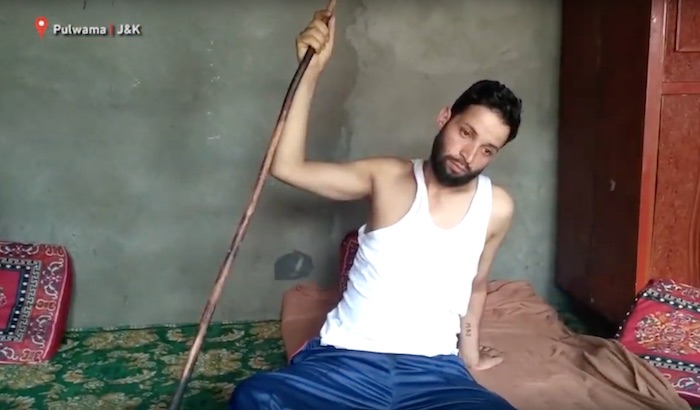In June 2017, Altaf Ahmad a resident of Aglar Pulwama, in the district of Pulwama, Kashmir, North India, was driving home from work on his bicycle. Living in Kashmir, one of the world’s most heavily militarized zones, 1 Altaf became the victim of unlawful military action, when he got shot three times by members of the Indian military who took him for a militant. Altaf fell to the ground and was left for dead.
Almost immediately after the incident, Rayees Ahmad, a community correspondent of Kashmir Unheard received a message about what had happened. He rushed to the scene only to discover no one was allowed to come near Altaf. After waiting for some time Rayees and a few others couldn’t bear merely standing by and drove over. Surprised to discover Altaf still alive, Rayees helped to quickly get him to a nearby hospital. After receiving emergency treatment, it became clear Altaf would need long-term medical treatment and undergo surgery if he wanted to be able to move around again freely.
Kashmir Unheard consists of a group of 23 community correspondents motivated by the desire to show the world ‘their’ Kashmir. They were formed in September 2014 after a training for aspiring local activists by Video Volunteers, a partner of the Video for Change Network based in Goa, India.
Currently supported by two editors and a coordinator, Kashmir Unheard’s ‘newly-minted story-tellers with cameras-in-hand’ are actively capturing the ‘unheard’ stories happening in their communities. Their methodology is simple: first, they discuss the issues they want to document with the affected communities, in order to raise their support and make sure the message is conveyed properly. Then a call-to-action is identified collectively and the resulting videos are made public using a variety of popular social media platforms. Kashmir Unheard’s videos are unique in the sense that most videos end with a clear call-to-action.
When Rayees first discussed the idea of making a video about his incident with Altaf, he refused. He was too afraid of what might happen. After two more meetings though, Altaf changed his mind and agreed to make his story public. Rayees and Altaf chose to leave all very graphic and violent footage out. The focus of the video was around Altaf and how the incident has affected his family: their young child, Altaf’s pregnant wife, and their highly uncertain future.

Rayees Ahmad
Quickly after the videos’ publication in July 2017, Altaf’s story went viral. On Facebook alone, it was shared 5000 times and seen by over 200,000 people. Support for Altaf and his family started pouring in. Many people wanted to help and were curious to know how Altaf’s recovery went. Altaf had strongly refused to ask for money in the video, but confronted with the wave of support for his family it was decided that Kashmir Unheard, who managed the outreach campaign, was allowed to share the bank account details of Altaf. A second rendition of the video was made, ending with a call-to-action to support Altaf and his family. Four months later enough money was raised for Altaf to undergo surgery (December 2017), cover the medical costs of the delivery of their second baby, renovate their house, pay the school fees of their older child and start up a provisional shop selling basic household necessities, which Altaf still runs today.
The positive monetary impact, although some people called his wife a ‘digital beggar’, stands in stark contrast to Altaf’s struggle for justice. The video was brought to the attention of the district commissioner of Pulwama district and reported to the police. Again, financial compensation was given, but no further investigation took place and the soldier firing the shots has never been prosecuted. All the while Altaf remains partly disabled and traumatized for life. In this impact video, published in February 2018, more is explained about the impacts of the video for change initiative for Altaf and his family.
“We have to be very careful because anything can happen to anyone in Kashmir.” –Rayees Ahmad, Community Correspondent Kashmir Unheard.
Working as a community correspondent for Kashmir Unheard is not without risk. In an interview with EngageMedia, Rayees, who besides Altaf’s case documents other human rights offenses in Kashmir, explains that in Kashmir one has to be very careful, avoid the army and be aware that sometimes videos simply ‘disappear’ after being publicized online. Rayees never forgets the day (April 2018) he was harassed in front of his parents’ house by military personnel. Soldiers in uniform beat him and snatched his phone, “they threatened me, kept asking me if I worked for the government and told me to stop investigating things,” he said.
It remains unclear whether the military’s visit relates directly to the Altaf video, or Rayees other activities for Kashmir Unheard, which he joined in 2017, producing 45 videos thus far. The incident has however strengthened him in his conviction to keep working as a community correspondent: “I am a journalist, I am supposed to be doing what I am doing! I am not afraid, I will not stop!” Rayees’ confidence, commitment and Kasmir Unheard’s style of working has earned him the direct support of the district commissioner of Pulwama, whom he calls his friend now and helps to protect him.
“I am very happy to see that Altaf Ahmad is running his own shop now.” –Gh Mohd Dar, District Commissioner of Palwama

